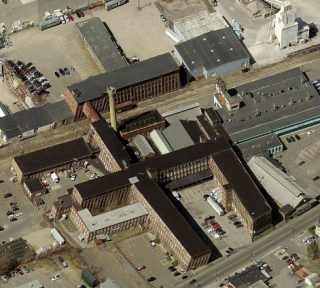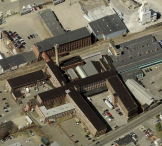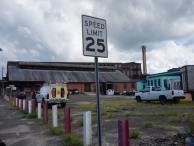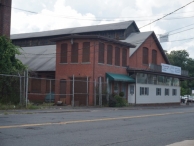Mill Record Waterbury
RETURN TO ‘FIND MILLS’Disclaimer: Content for these properties was compiled in 2014-2017 from a variety of sources and is subject to change. Updates are occasionally made under Property Information, however the Connecticut Trust for Historic Preservation (dba Preservation Connecticut) makes no representation or warranty that the information is complete or up-to-date.
- Complex Name (Common)
- American Pin Co.
- Complex Name (Historic)
-
- American Pin Co.
- Address or Location
- 1643-1669 Thomaston Avenue, Waterville, Waterbury
- County
- New Haven
- Historic Designation
- Associated Mill Community
- n/a
 What can you do at this mill?
What can you do at this mill?
- Historic Information
Companies Associated w/Complex
- American Pin Co. 1894-1923
- Scovill Manufacturing Co., American Pin Co. subsidiary 1923-1970s
Use (Historic)
Largest Documented Workforce
n/a
Historic Narrative
In the 1830s, having witnessed the complex manual process of making pins, Ridgefield native John Howe (1793-1876) patented a machine to make common pins. He established the Howe Manufaturing Co. in 1833 in New York, moving to Derby c.1836, and worked on improving the machine. Eventually, he also automated the pin packaging process. Howe collaborated with the Waterbury firm Benedict and Burnham to establish the American Pin Company in 1846. The first American Pin factory was located on East Main Street, but in 1894 the factory moved to a new complex in the Waterville section of Waterbury. The American Pin Company was one of two dominant pin makers in the Naugatuck Valley in the 19th century, the other being the Oakville Pin Company. In 1923, both brass-using companies were purchased by the Scovill Manufacturing Company which had prospered during World War I through its production of ordnance, especially brass shell casing, and military uniform buttons. Scovill operated the American Pin Company successfully through World War II, but by the 1950s the pin making industry in Waterbury began to decline. Several waves of labor unrest swept through the company and its subsidiaries in the 1950s, the 1955 flood damaged the factory, and raw material costs were rising. By the mid-1970s, Scovill moved its operations to Georgia and closed the Waterville plant. Since then the building has been occupied intermittently by non-industrial tenants.
- Architectural Information
Number of Existing Buildings
Over fifteen (15) blocks.
Dates of Construction
1894, c.1901-1906, c.1913-1916 with modern additions
Architect
n/a
Builder
n/a
Building Type
Architectural Description
The earliest group of blocks was built c.1894 and consists of the 4-story central north/south brick pier main block (50 x 360 ft), 2-story brick office building off its south end, 4-story brick pier western wing (50 x 150 ft) and the first brick power house complex to its north. The next phase of construction is represented by a 4-story brick extension to the north end of the main block and a 1-story brick foundry building to its west c.1901-2. There were two later bursts of construction: in 1905-6, the two 4-story brick pier wings off the east side of the main block (50 by 200 ft north wing; 50 x 250 ft south wing), and the 4-story brick pier storehouse on the west side of the railroad tracks (60 x 250 ft); in 1913-16, a new gable-roof one-story brick foundry with monitor at the northeast end of the complex (55 x 165 ft), a 2-story brick ell connecting the east side of the office to the south side of south wing, a 1-story brick machine room along the southwest end of the main block, a new brick power house along the east side of the tracks north of the western wing, and the 2-story brick storehouse along the east side of the tracks south of the western wing (50 x 150 ft). There are other smaller infill buildings, as well as later additions from the 1930s and 1950s.
Exterior Material(s)
Structural System(s)
Roof Form
Roof Material
Power Source
Condition
Good
Condition Notes
n/a
- Property Information
-
Specific Location
Six parcels totaling 12.18 acres west of Thomaston Avenue opposite Driggs and Sheffield Streets (two on west side of railroad), the majority at 1643 and 1669 Thomaston Avenue.
Adjacent To
Exterior Visible from Public Road?
Yes
Parcel ID / Assessor Record Link
- 0074-0973-0005 / Link →
- 0074-0973-0009 / Link →
- 0064-0973-0009 / Link →
- 0074-0973-0002 / Link →
- 0074-0973-0001 / Link →
- 0074-0973-0048 / Link →
Acreage
4.0; 0.87; 1.12; 2.7; 1.85; 1.64
Use (Present)
- Sources
-
Form Completed By
Michael Forino
Date
August 2015
Bibliography
- Hartford Courant.
- Anderson, Joseph, Sarah J Prichard, and Anna Lydia Ward. The Town and City of Waterbury, Connecticut from the Aboriginal Period to the Year Eighteen Hundred and Ninety-Five. New Haven: Price and Lee Co., 1896.
- Pape, William J. History of Waterbury and the Naugatuck Valley, Connecticut,. Chicago; New York: The S. J. Clarke Publishing Company, 1918.
- Kelley, Etna M. The Business Founding Date Directory. Scarsdale, N.Y.: Morgan & Morgan, 1954.
- Representative View(s)Click on image to view full file








